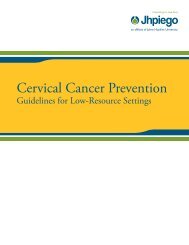Manual for Male Circumcision under Local Anaesthesia
Manual for Male Circumcision under Local Anaesthesia
Manual for Male Circumcision under Local Anaesthesia
You also want an ePaper? Increase the reach of your titles
YUMPU automatically turns print PDFs into web optimized ePapers that Google loves.
<strong>Male</strong> circumcision <strong>under</strong> local anaesthesia<br />
Version 3.1 (Dec09)<br />
in<strong>for</strong>mation private and allow clients to decide when and with whom to<br />
discuss their sexual and reproductive health problems. Clients will feel<br />
more com<strong>for</strong>table about sharing personal in<strong>for</strong>mation with counsellors<br />
and being tested <strong>for</strong> STIs or HIV if they know that this in<strong>for</strong>mation will<br />
remain secret. This also applies when the client’s main interest is male<br />
circumcision. An atmosphere of trust will encourage clients to discuss<br />
other sexual and reproductive health needs.<br />
Another reason why confidentiality is so important is that many people<br />
have negative feelings about STIs, HIV/AIDS and sexual health<br />
concerns. There is strong social pressure to con<strong>for</strong>m, and<br />
considerable social stigma is associated with behaviours or conditions<br />
perceived as unusual.<br />
Sometimes, health care workers at a clinic need to know a client’s HIV<br />
status. This happens, <strong>for</strong> example, when a client is sick and the best<br />
treatment depends on knowing whether the person is HIV-positive or<br />
HIV-negative. The counsellor should tell the client about this possibility<br />
during counselling. An HIV test is recommended <strong>for</strong> all clients<br />
requesting circumcision, but is not required <strong>for</strong> the operation to go<br />
ahead. <strong>Male</strong> circumcision can be safely per<strong>for</strong>med in men whose HIV<br />
status is unknown and in those with HIV infection, provided that they<br />
are clinically healthy. However, except in some rare cases where<br />
circumcision is necessary to correct a health problem of the glans or<br />
<strong>for</strong>eskin in a man with HIV infection, there are no medical or public<br />
health reasons to per<strong>for</strong>m circumcision in men with HIV infection. HIV<br />
testing of clients be<strong>for</strong>e circumcision is not necessary to protect the<br />
clinic or surgical staff during the operation. It is important that the clinic<br />
applies high infection-control standards, including proper<br />
implementation of universal precautions to minimize the risk of<br />
transmission of HIV and other infections to health care workers or<br />
other patients. Universal precautions are discussed in full in Chapter<br />
8.<br />
Counselling skills<br />
All counsellors need certain basic counselling skills in order to talk<br />
with clients in a helpful way. Some of these skills are explained below.<br />
Empathizing<br />
Empathy is the ability to see the world through another person’s eyes<br />
and <strong>under</strong>stand how that person feels. Counsellors should listen to<br />
clients carefully and show them that they <strong>under</strong>stand without judging.<br />
Empathy is not sympathy; it is not feeling sorry <strong>for</strong> the client. Empathy<br />
is <strong>under</strong>standing the client’s feelings.<br />
Example:<br />
An adolescent says to the counsellor: “My girlfriend keeps asking<br />
me to go <strong>for</strong> circumcision. I feel embarrassed and angry.”<br />
Educating and Counselling Clients and Obtaining In<strong>for</strong>med Consent Chapter 3-6
















